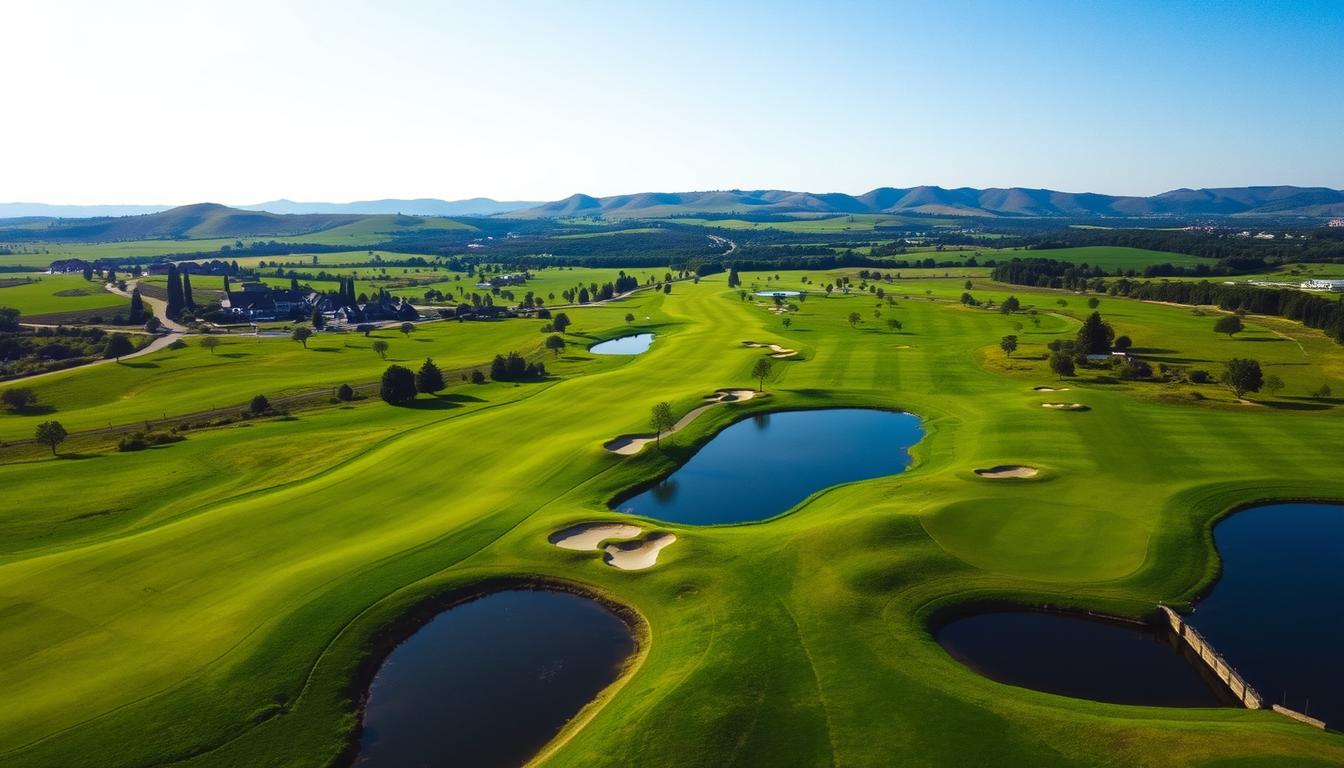Did you know the world’s longest golf course is over 1,365 kilometers long? It runs along the Eyre Highway in Australia. This shows how different golf course sizes can be. From small urban courses to large championship ones, knowing golf course acreage is important for the designer to maximize the earning potential of the space.
The size of a golf course depends on many things. This includes the number of holes, the terrain, and the design. A typical 18-hole course might need 74 to 150 acres. For example, Circling Raven Golf Club in Idaho covers 620 acres for its 72-par course.
Ala Wai Golf Course in Hawaii is another example. It fits a 70-par course in just 145 acres. This shows how different course sizes can be.
Nine-hole courses need less land, from 20 to 60 acres. Sweetens Cove Golf Club in Tennessee is a big example, covering over 420 acres for a 9-hole round. Winter Park Golf Course in Florida, however, fits a 35-par game in just 40 acres.
But course size isn’t just for full-sized layouts. Putt-putt courses need only about half an acre. Driving ranges or pitch and putt courses cover around 12 acres. Executive golf courses, made for quick play, can fit on 40 to 50 acres.
Key Takeaways
- 18-hole golf courses typically require 74 to 150 acres of land
- 9-hole courses range from 20 to 60 acres
- Putt-putt courses need only about half an acre
- Executive courses fit on 40 to 50 acres
- Course size varies based on design, terrain, and location
- The world’s longest golf course spans over 1,365 kilometers
Table of Contents
- 1 Understanding Golf Course Acreage
- 2 How Many Acres in a Golf Course: Typical Ranges
- 3 Standard 18-Hole Course Acreage
- 4 Variations in 9-Hole Course Sizes
- 5 Par 3 Courses: Minimal Land Requirements
- 6 Executive Courses: Balancing Size and Playability
- 7 Championship Courses: Maximizing Land Use
- 8 Urban Golf Courses: Making the Most of Limited Space
- 9 Resort Courses: Expansive Layouts and Scenic Views
- 10 Components of a Golf Course and Their Acreage
- 11 Factors Affecting Golf Course Acreage
- 12 The Impact of Terrain on Course Acreage
- 13 Environmental Considerations in Course Design
- 14 Acreage Requirements for Practice Facilities
- 15 Historical Trends in Golf Course Acreage
- 16 Unique Golf Course Acreage Examples
- 17 Comparing Golf Course Sizes Around the World
Understanding Golf Course Acreage
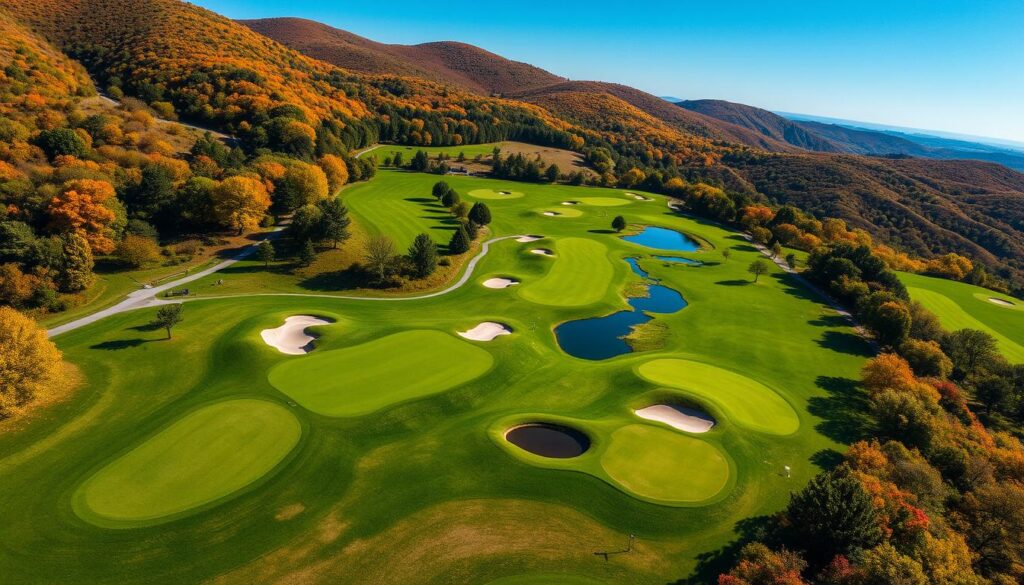
Golf course layout and acreage are important to the golfing experience. The size of a golf course varies. It depends on location, terrain, and design.
Defining an Acre in Golf Terms
In golf, an acre is like a 400-yard par 4 hole. This helps us understand golf course sizes. For example, Circling Raven Golf Club in Worley, Idaho is 620 acres with a max length of 7,189 yards.
Factors Influencing Course Size
Several things affect course size:
- Number of holes
- Terrain complexity
- Desired difficulty level
- Available land
Urban courses like Ala Wai Golf Course in Honolulu are smaller (145 acres). But, courses like Sweetens Cove Golf Club in Tennessee cover 420 acres for just 9 holes.
The Importance of Land Management in Golf
Good land management is crucial for great golf courses. A typical 18-hole course is 110 to 190 acres. Here’s how it’s divided:
| Course Area | Percentage |
|---|---|
| Rough | 60% |
| Fairways | 29% |
| Driving Range | 6% |
| Tees and Greens | 5% |
Planning these areas well balances challenge and fun. It also considers the environment.
How Many Acres in a Golf Course: Typical Ranges
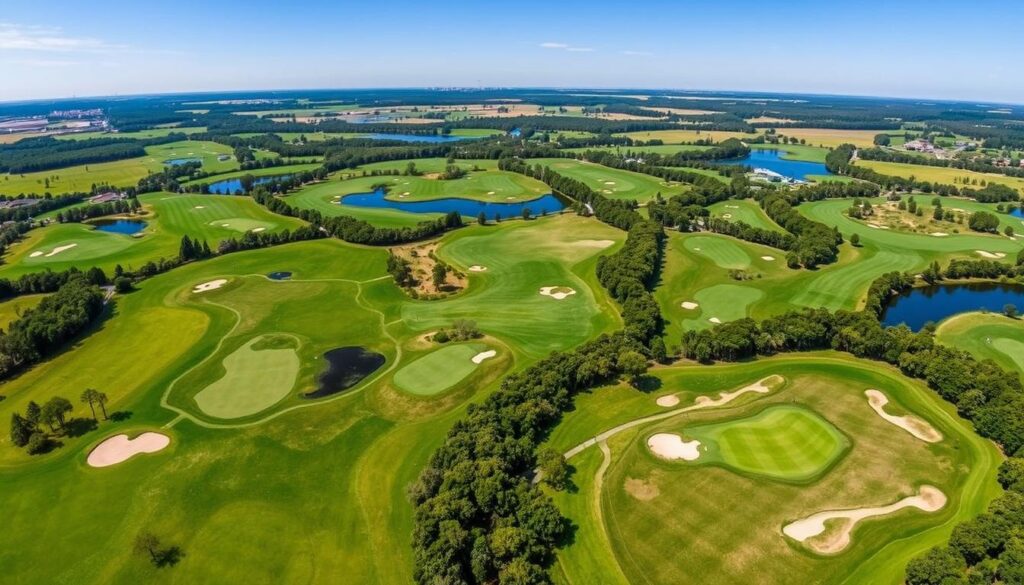
Golf course sizes vary a lot. This shows different types of courses and design ideas. You’ll see many different sizes for different golf course types.
Full-size 18-hole courses usually cover 120 to 200 acres. This big space lets designers create varied holes, hazards, and beautiful views. Executive courses, for faster play, need 40 to 50 acres. Par 3 courses, which focus on short game skills, require about 30 acres.
How big a course is depends on the terrain, natural features, and local rules. Fairways and greens use 30% to 40% of the area. The rest is for roughs, hazards, and natural spaces.
| Course Type | Typical Acreage | Features |
|---|---|---|
| 18-Hole Standard | 120-200 | Full-length holes, diverse layouts |
| Executive | 40-50 | Shorter holes, quicker play |
| Par 3 | 30 | All par-3 holes, focus on short game |
| Driving Range | 12 | Practice facility, no full holes |
Today, golf course design is moving towards being more sustainable. Courses use less land but still offer great golfing. They use new drainage systems and grass types that are more resilient. This way, they save resources without losing the fun of playing golf.
Standard 18-Hole Course Acreage
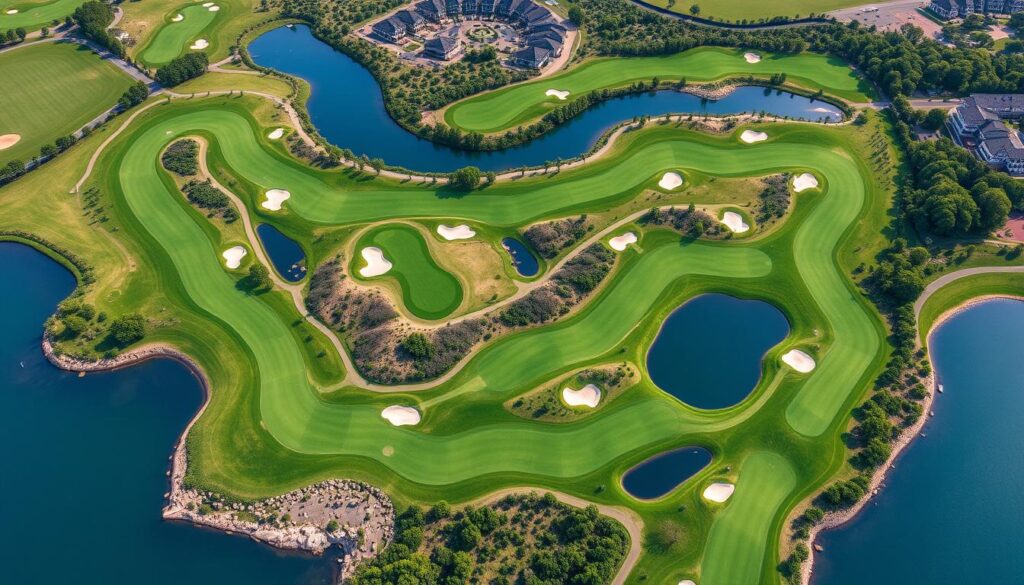
A typical 18-hole course size ranges from 120 to 180 acres. This space allows for full-length holes, practice areas, and essential facilities. The course layout greatly influences the exact acreage needed.
Golf courses vary widely in size due to unique designs and local conditions. For example, Circling Raven Golf Club in Worley, Idaho, spans an impressive 620 acres for its championship layout. On the other hand, Ala Wai Golf Course in Honolulu occupies a more modest 145 acres for its par 70 design.
Building an 18-hole golf course is a big project. It takes 6-12 months to build, and another 12-18 months for grass to grow before it opens. The cost can range from $2.5 million to $10 million, depending on location and design complexity.
| Golf Course | Location | Acreage | Green Fee (Weekday) | Green Fee (Weekend) |
|---|---|---|---|---|
| Circling Raven Golf Club | Worley, Idaho | 620 | $89 | $109 |
| Ala Wai Golf Course | Honolulu, Hawaii | 145 | $28 | $38 |
Golf course design involves several stages. These include initial layout planning, permit acquisition, and detailed drawing development. This process often takes at least a year to complete. The final design must balance player experience with environmental considerations and maintenance requirements.
Variations in 9-Hole Course Sizes
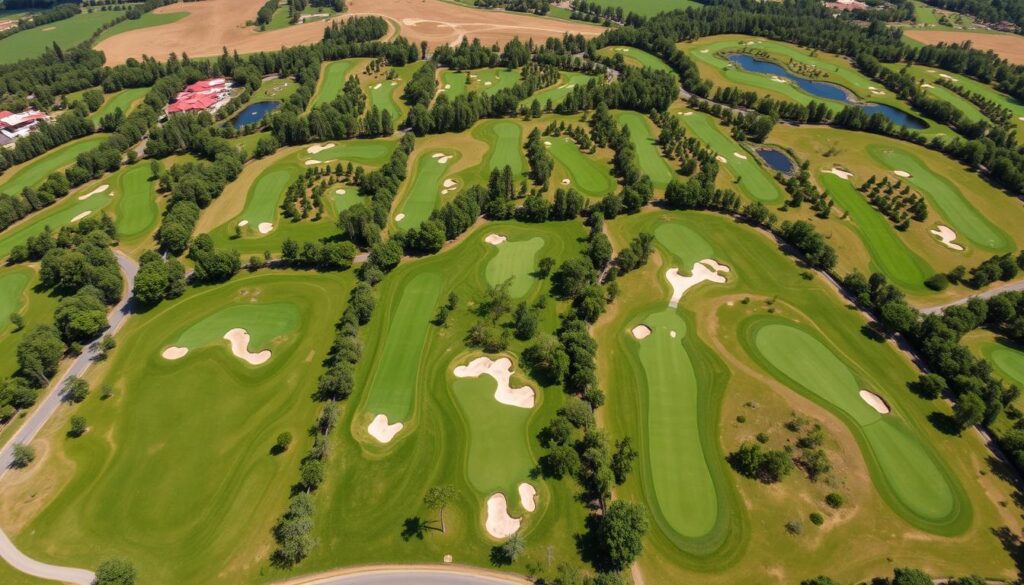
9-hole golf courses come in all sizes, giving players different experiences. They can be as small as 20 acres or as big as 60 acres. Let’s look at the range of 9-hole layouts, from small to large.
Compact 9-Hole Designs
Compact 9-hole courses use space wisely. They usually cover 30 to 50 acres, ideal for cities or small areas. The Winter Park Golf Course in Florida is a great example, with only 40 acres.
These courses have short par-3 and par-4 holes. They are fun and easy to play, making golf accessible to everyone.
Spacious 9-Hole Layouts
Some 9-hole courses are as big as 18-hole courses. Sweetens Cove Golf Club in Tennessee is a big example, covering 420 acres. These large courses have longer holes, wider fairways, and more hazards.
They offer a top-notch golfing experience. Players get to enjoy a full game without the need for 18 holes.
| Course Type | Typical Acreage | Example |
|---|---|---|
| Compact 9-Hole | 30-50 acres | Winter Park Golf Course (40 acres) |
| Spacious 9-Hole | 60-420 acres | Sweetens Cove Golf Club (420 acres) |
9-hole courses offer a wide range of experiences. Small courses are quick and easy to get to. Big courses give a full golfing adventure.
Whether you want a fast game in the city or a long day in the countryside, 9-hole courses have something for everyone.
Par 3 Courses: Minimal Land Requirements
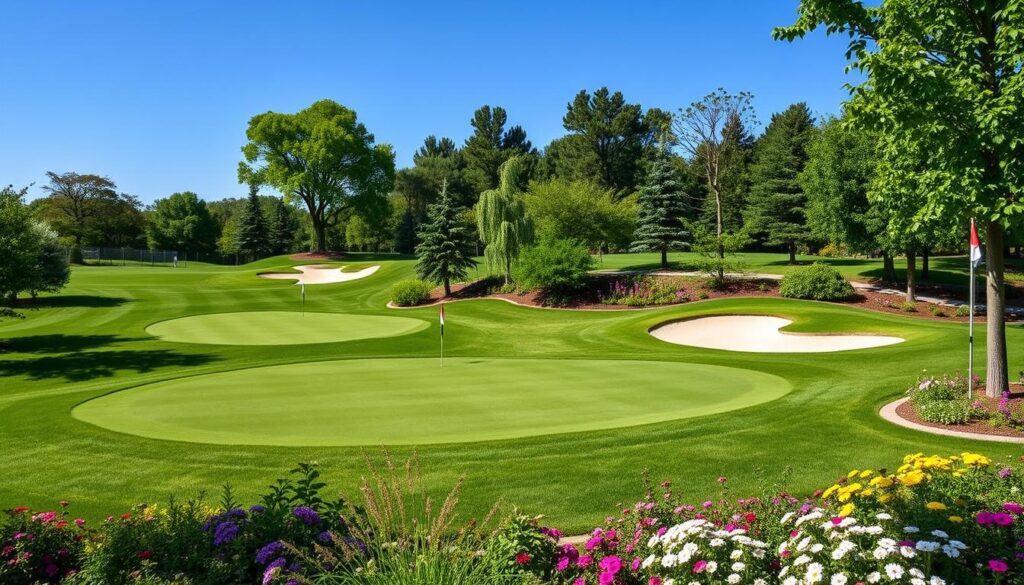
Par 3 courses are great for those who love golf but have little space. They need only 30 to 40 acres for an 18-hole game. This small size lets them fit into tight spots, like cities.
Compared to regular 18-hole courses, par 3 courses are much smaller. They take up less land, making them perfect for quick games and improving your skills. Both golf lovers and developers find them appealing.
Each par 3 hole is about one acre big, with lengths from 60 to 150 yards. This setup offers a fun yet manageable golf experience. The course par changes based on its design, adding unique challenges in a small area.
| Course Type | Acreage | Typical Hole Length |
|---|---|---|
| Standard 18-hole | 100-200 acres | Varies (Par 3, 4, 5) |
| Par 3 (18-hole) | 30-40 acres | 60-150 yards |
| Pitch & Putt (9-hole) | 20-25 acres | Less than 60 yards |
Par 3 courses are also budget-friendly. Building one can cost between $25,000 to $50,000 per hole. Their small size and affordable price make them a smart choice for golf fans and developers looking to use land wisely.
Executive Courses: Balancing Size and Playability
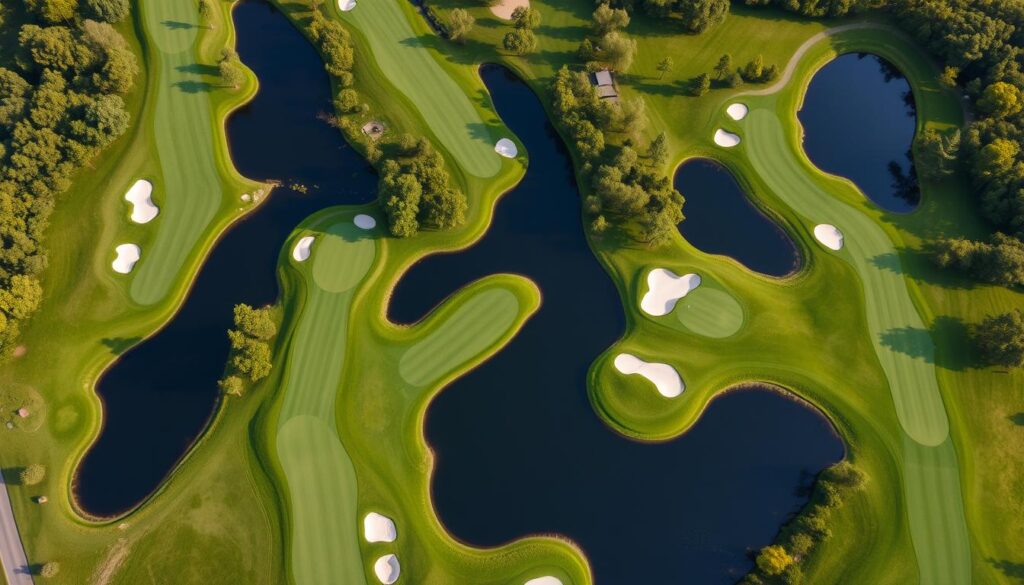
Executive courses offer a unique golfing experience. They combine compact layouts with efficient land use. These courses usually cover 40 to 75 acres, finding a balance between full-sized and par 3 layouts.
With lengths from 3,000 to 4,500 yards, they cater to golfers of all skill levels. This makes for an engaging round.
Ideal Acreage for Executive Courses
Executive course design focuses on smart space use. Most layouts need half the land of a standard 18-hole course. This approach allows for creative hole arrangements and diverse playing experiences in a smaller space.
Design Considerations for Compact Layouts
Compact golf layouts require innovative strategies. Designers mix par 3 and par 4 holes, with the occasional par 5. This mix ensures an exciting round while keeping the course size manageable.
| Course Type | Acreage | Length (Yards) | Par |
|---|---|---|---|
| Executive | 40-75 | 3,000-4,500 | 58-68 |
| Regulation | 100-200 | 6,300-6,700 | 72 |
| Par-3 | 35-45 | 2,000-2,500 | 54 |
Executive courses attract a wide range of players. They appeal to juniors, seniors, and casual golfers. A round here usually takes about 3 hours, perfect for those short on time.
The shorter layout also saves on construction costs. Savings can be 20-25% compared to full-sized courses.
Championship Courses: Maximizing Land Use
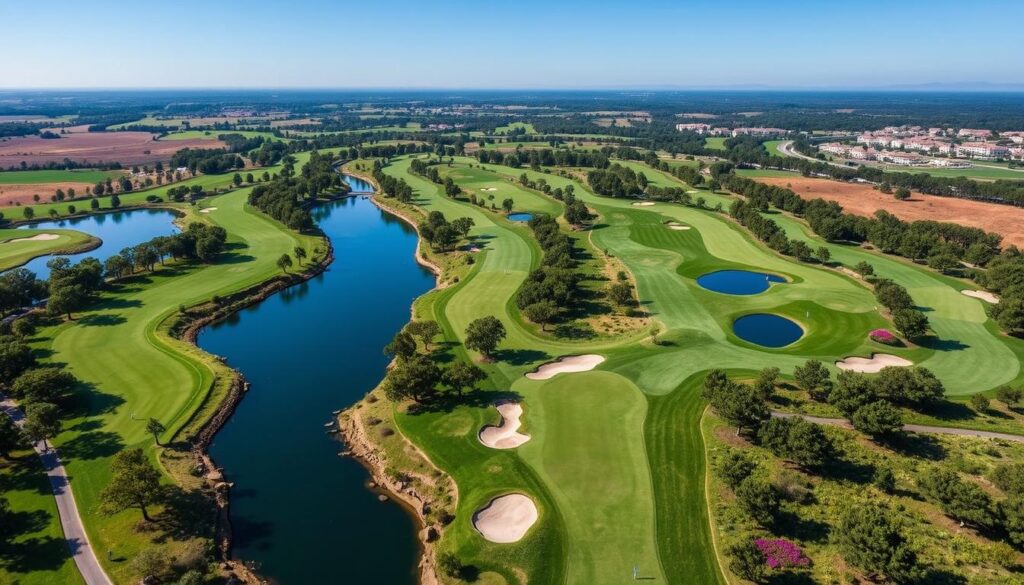
Championship courses are top-notch golf venues. They have huge layouts that use a lot of land. These places usually cover 150 to 200 acres, sometimes more.
Circling Raven Golf Club in Idaho is a great example. It covers an amazing 620 acres. This size lets them have long holes, wide fairways, and big practice areas. It’s perfect for professional golf and big tournaments.
Golf uses a lot of land worldwide. In the U.S., golf takes up about 2.3 million acres. Globally, it’s over 5 million acres. Most golf places have 30 acres for nature and areas not used for play.
But, some famous courses show you can play great golf on less land. For example, the Club de Golf del Uruguay has only 89 acres. The Old Course at St. Andrews in Scotland is even smaller, at 95.1 acres.
| Golf Course | Location | Acreage | Yardage |
|---|---|---|---|
| Circling Raven Golf Club | Idaho, USA | 620 | 7,189 |
| Club de Golf del Uruguay | Uruguay | 89 | 6,932 |
| Old Course at St. Andrews | Scotland | 95.1 | 7,305 |
| Town and Country Club | Minnesota, USA | 99 | 6,400 |
Urban Golf Courses: Making the Most of Limited Space
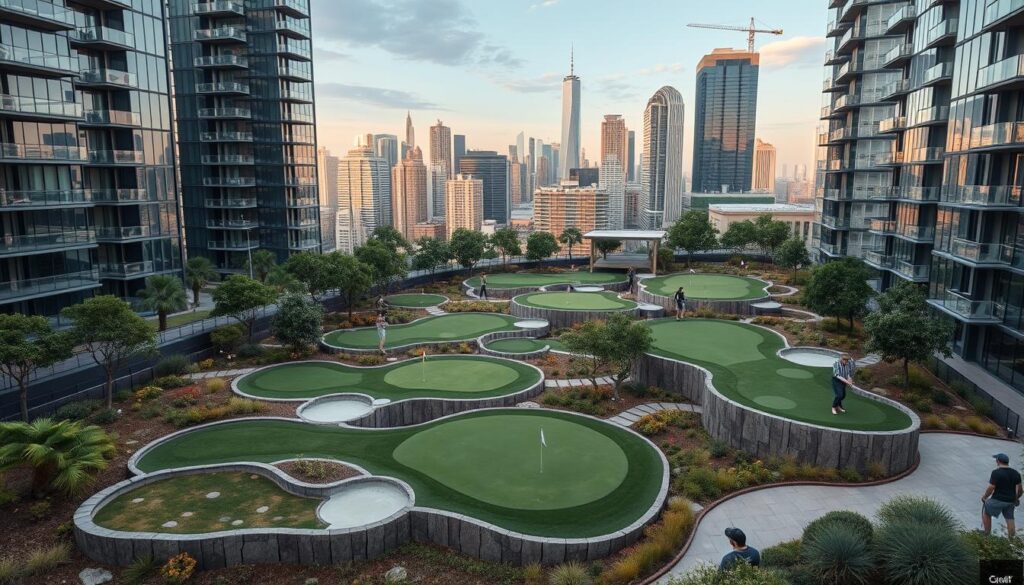
City golf courses have unique challenges. With little land, they use smart design to make the most of what they have. These courses show that you don’t need a lot of space for a great golf experience.
Innovative Design Techniques
Urban golf architects use clever tricks to make the most of small spaces:
- Multi-use spaces that serve as driving ranges by day and pitch & putt courses by night
- Compact par-3 layouts that fit into smaller footprints
- Creative routing to use every inch of land
- Vertical elements like multi-tier driving ranges
Examples of Successful Urban Courses
Many city golf facilities are great examples of smart space use:
| Course | Location | Acreage | Features |
|---|---|---|---|
| Ala Wai Golf Course | Honolulu, HI | 145 acres | 18-hole par 70 in dense urban area |
| Furrows Course | Kingston Heath, Australia | 20 acres | 9-hole par-3 course |
| Himalayas Putting Course | St Andrews, Scotland | 3 acres | 18-hole putting course |
These examples show that urban golf courses can offer fun play in small spaces. By using creative solutions, city golf facilities can still thrive, even with limited space.
Resort Courses: Expansive Layouts and Scenic Views
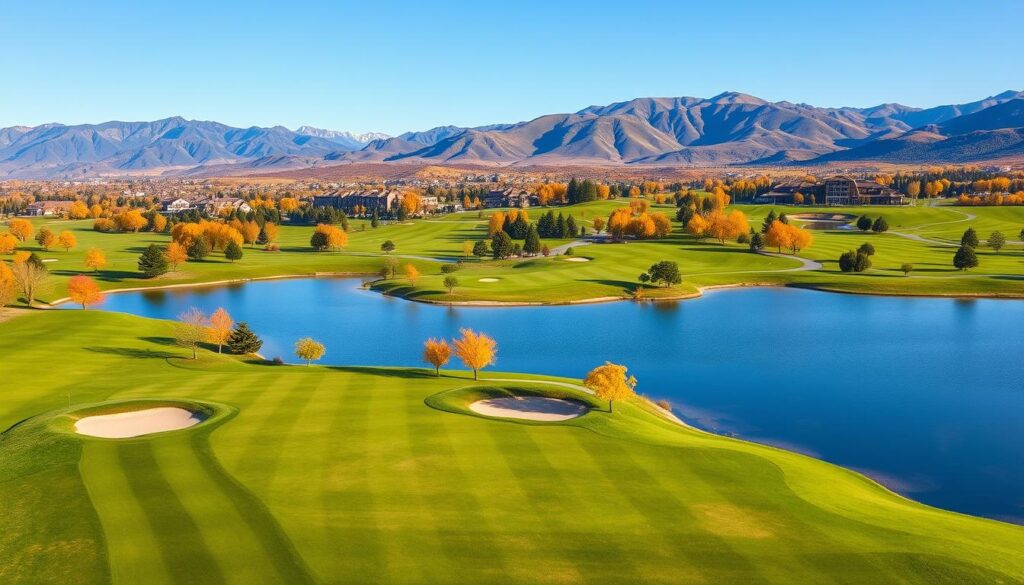
Resort golf courses are known for their large layouts and beautiful scenery. These spots often cover over 200 acres. This lets architects create courses that blend with nature.
Many of these courses focus on looking good and playing well. They use local features like mountains and forests in their design. This makes for a unique golfing experience that’s as beautiful as the area around it.
- Pinehurst Resort (North Carolina): 189 holes across 11 courses
- Boyne Golf (Michigan): 162 holes within 10 courses at 3 resorts
- Bandon Dunes (Oregon): 122 holes with 5 18-hole courses
- Reynolds Lake Oconee (Georgia): 117 holes among 6 championship courses
Let’s look at rates for a popular resort golf destination:
| Course | Weekday Rate | Weekend Rate | Twilight Rate |
|---|---|---|---|
| Eisenhower | $84.00 | $99.00 | $60.00 |
| Zaharias | $79.00 | $89.00 | $60.00 |
These rates show the high-quality experience of resort courses. The Eisenhower course ranges from 5,662 to 7,221 yards. The Zaharias course covers 650 acres. Both were designed by William F. Bell and offer challenges for all skill levels.
Components of a Golf Course and Their Acreage

Golf course components are important in planning and using land. Knowing how much space each part needs helps design better courses.
Tee Boxes and Greens
Tee boxes usually take up 3-5 acres. Greens need 3-6 acres. These areas are vital for starting and ending each hole.
Fairways and Rough Areas
Fairways and rough areas cover most of the course, about 60-90 acres. They are the main playing area and challenge for golfers.
Hazards
Sand bunkers and water features use 5-10 acres. They make the course harder and more beautiful.
Practice Areas and Driving Ranges
Practice facilities are crucial for improving player skills. Their size varies with the space available and the course type.
Clubhouse and Parking Facilities
These amenities support the course and guests. Their size depends on the course’s size and visitor numbers.
| Component | Typical Acreage | Percentage of Total Course |
|---|---|---|
| Tee Boxes | 3-5 | 2-3% |
| Greens | 3-6 | 2-3% |
| Fairways and Rough | 60-90 | 50-60% |
| Hazards | 5-10 | 3-5% |
| Practice Areas | 10-20 | 5-10% |
| Clubhouse and Parking | 5-15 | 3-8% |
Factors Affecting Golf Course Acreage
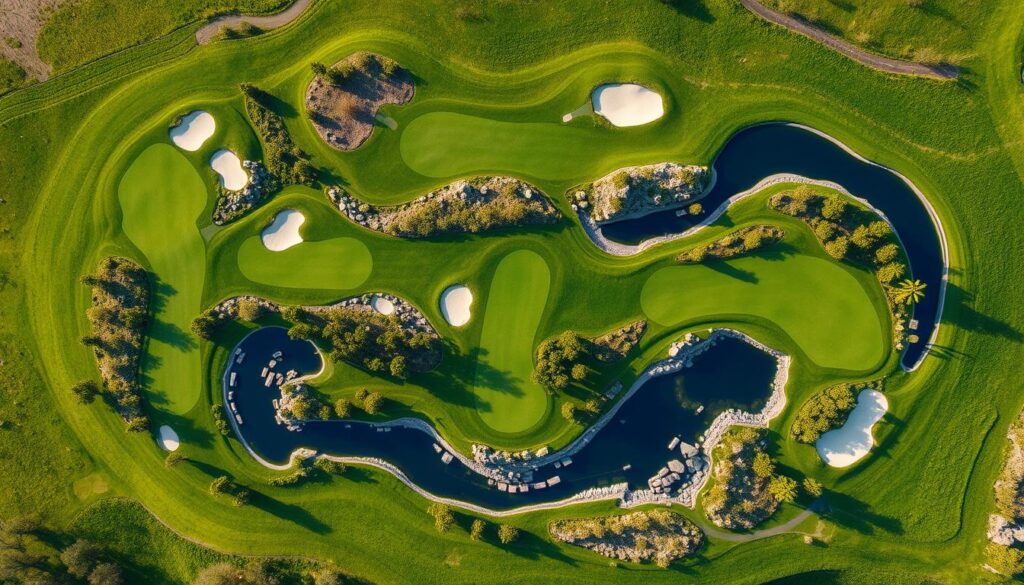
Golf course design is critical to figuring out how much land is needed. The size of a golf course depends on many things. These include how hard the course is, the land’s features, and how it affects the environment.
Course Difficulty and Design
The course’s difficulty level affects its size. Harder courses need more land for longer fairways and bigger hazards. In 2021, a typical 18-hole course had 95 acres for grass, with 49 acres for roughs and 27.1 acres for fairways.
Geographical Location and Terrain
The land’s shape greatly influences the course’s design. Hilly areas need more land for playable holes. Flat areas use land more efficiently. Drainage systems also shape the course, especially in rainy areas.
Environmental Impact
Thinking about the environment is crucial in golf course design. Many courses use natural features, with 26% of U.S. golf land dedicated to this in 2015. Water features cover 159,072 acres, making up 6.9% of golf land.
Regulatory Requirements
Rules and regulations shape course size and layout. Designers must follow local laws and environmental rules. These can either limit or expand the land available for courses.
Budget Constraints
Money matters a lot in course size. Bigger courses need more land, materials, and upkeep. This affects both the cost to build and the ongoing expenses.
| Golf Course Component | Average Acreage (18-hole facility) |
|---|---|
| Roughs | 49.0 |
| Fairways | 27.1 |
| Practice Areas | 5.9 |
| Greens | 3.3 |
| Tees | 3.1 |
The Impact of Terrain on Course Acreage
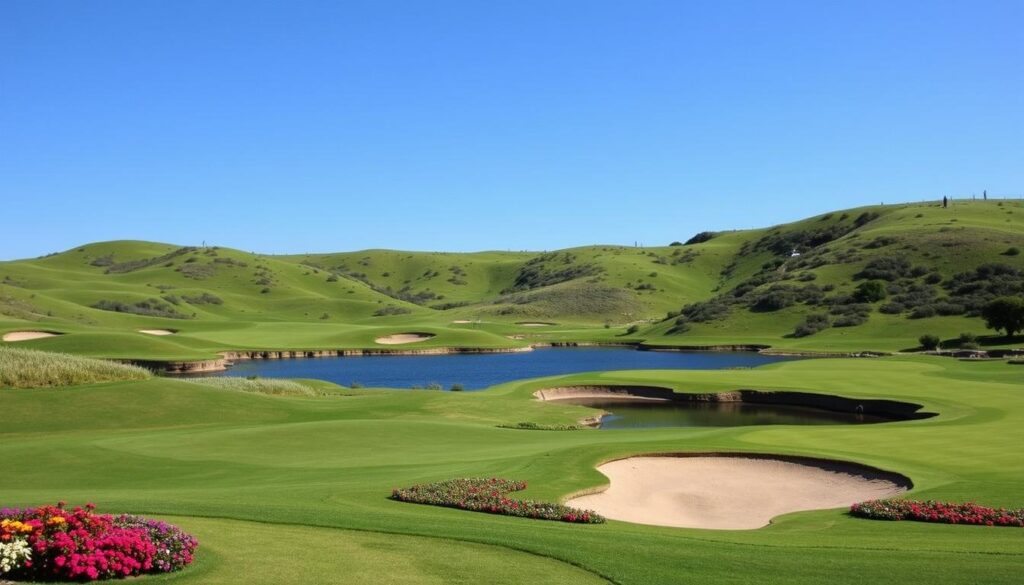
Golf course terrain is important because the natural features of the landscape shape the design and layout. This affects both how fun the course is to play and how it looks.
Hilly vs. Flat Landscapes
Hilly areas need more land for a good golf course. The ups and downs add challenge and beauty but take up more space. Flat areas are easier to build but might not be as pretty.
Designers must think carefully about these differences when planning golf course construction. Costs can vary from $7 million to $25 million for an 18-hole course.
Incorporating Natural Features
Using the natural landscape is crucial for making a course stand out. It makes the game more enjoyable and can save money. Features like water, forests, and rocks can add beauty or challenge.
In the U.S., golf courses cover about 1,504,210 acres. This shows how important careful planning and caring for the environment are. Some courses use native plants to save water and cut down on upkeep.
| Landscape Type | Acreage Impact | Design Considerations |
|---|---|---|
| Hilly | Increased | Elevation changes, drainage |
| Flat | Decreased | Artificial contouring, water features |
| Mixed | Varied | Natural hazard integration, scenic routing |
Designers who think about the terrain and natural features can make courses that are fun and good for the environment. This approach improves the game and helps use land wisely.
Environmental Considerations in Course Design
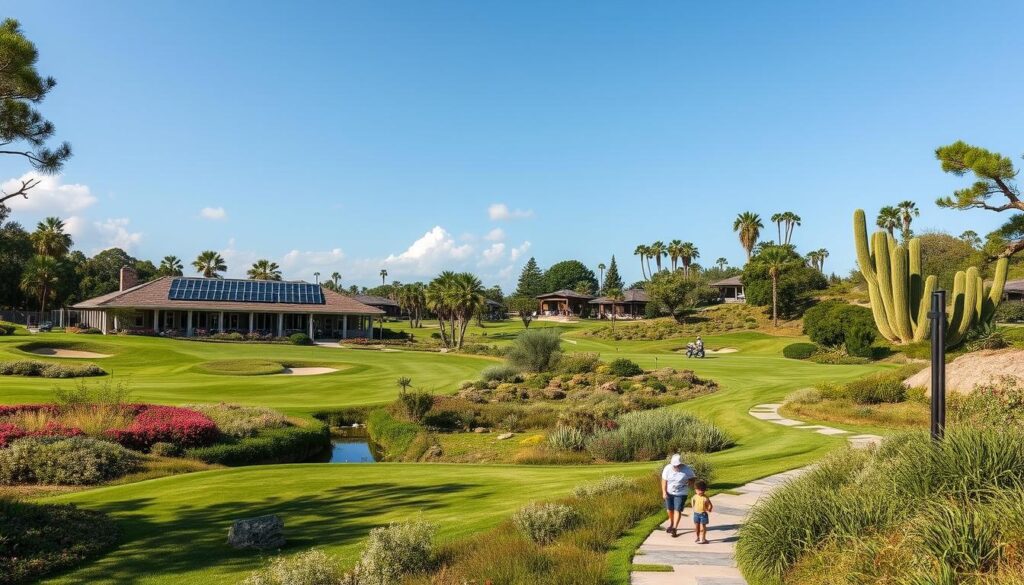
Golf course design now focuses on being eco-friendly and sustainable. Courses aim to be fun to play while also caring for the environment. This often means using more land to protect natural areas and water.
Designers use native plants to cut down on water and maintenance costs. They also install efficient irrigation systems and choose grasses that don’t need much water. These steps help make eco-friendly golf courses more common.
When building a course, the environment is a big concern. Designers are turning old, useless land like closed landfills into golf courses. This way, they create fun places to play while harming the environment less.
Managing water is important in sustainable design. Courses in dry areas might use a lot of water, while those in wetter places use less. Good water management includes:
- Adjusting sprinkler zones to avoid wasting water
- Using different water cycles for even coverage
- Watering at night or early morning
- Using smart irrigation systems
- Changing water plans based on weather
Soil drainage is important for the health of the grass. Sandy soils drain well, making the course firmer and faster. This affects the launch angle and how the game feels.
Now, courses focus on keeping wetlands and habitats for wildlife. These areas are home to many birds and animals. They help protect biodiversity in golf course areas.
| Grass Type | Drought Tolerance | Water Requirement |
|---|---|---|
| Warm-season (Bermuda, Zoysia) | High | Lower |
| Cool-season (Fescue, Bentgrass) | Low | Higher |
Acreage Requirements for Practice Facilities
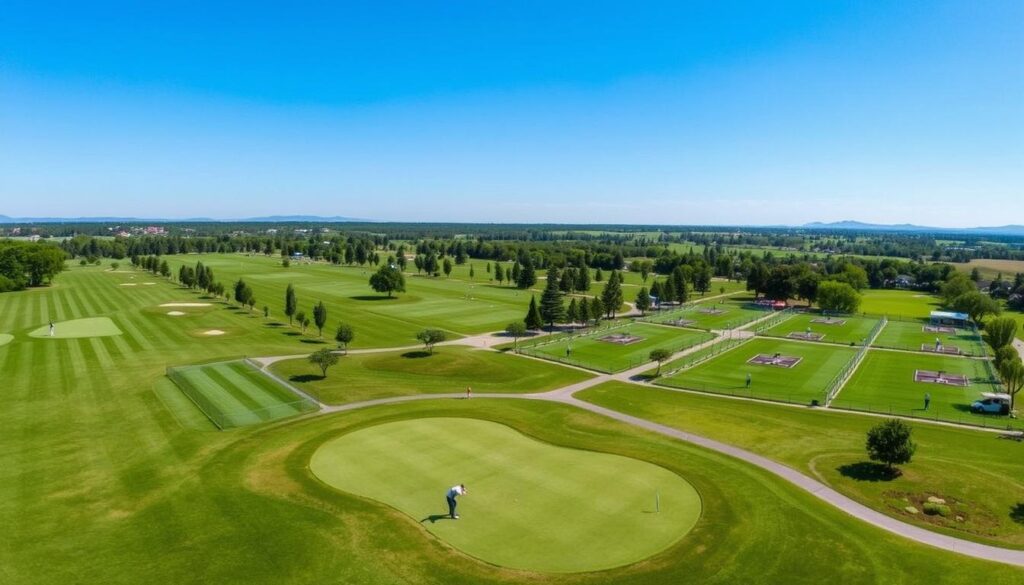
Golf practice facilities are important for player growth and course appeal. The size of the driving range and putting green area greatly affects the land needed for a golf course.
Driving Ranges
A full-size driving range usually needs 12-15 acres. This space allows for many hitting stations and enough room for golf balls to land. Larger courses might use even more space to fit more golfers at once.
Putting Greens and Chipping Areas
Putting greens and chipping areas take up 1-2 acres together. These areas are vital for improving short game skills. Some courses have multiple putting greens of different sizes and shapes to test players.
| Practice Facility | Typical Acreage |
|---|---|
| Driving Range | 12-15 acres |
| Putting Greens | 0.5-1 acre |
| Chipping Areas | 0.5-1 acre |
The size of practice facilities can change based on the course’s design and available land. Urban courses might have smaller practice areas. But resort courses often have bigger facilities to draw and keep golfers.
Historical Trends in Golf Course Acreage
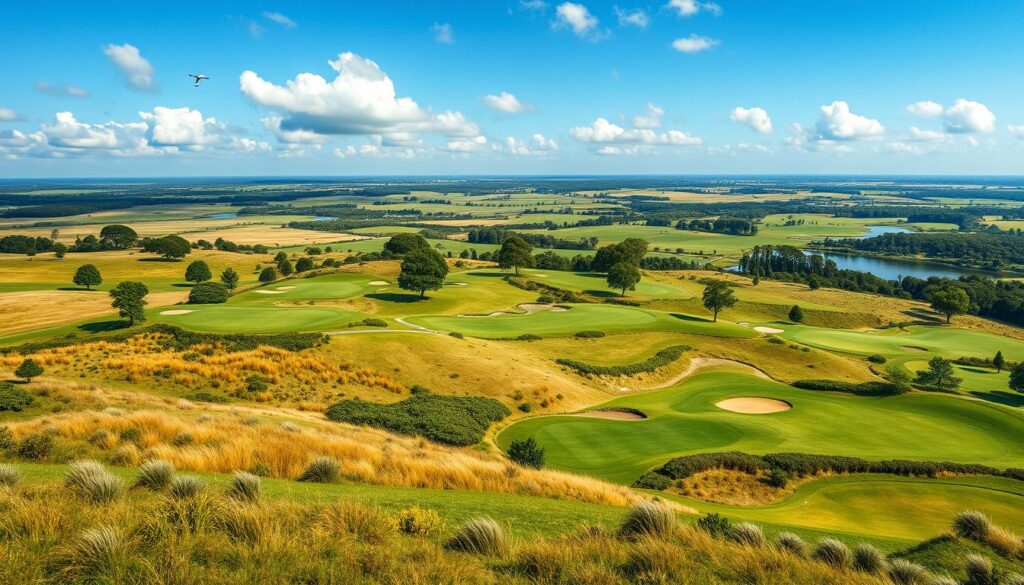
Golf course acreage has seen big changes over time. The evolution of golf courses shows how player needs, tech, and care for the environment have changed.
Evolution of Course Sizes
Older golf courses were smaller. Now, the U.S. has over 16,000 courses, each about 100 acres big. This growth shows golf’s growing popularity and its effect on land use.
Impact of Modern Equipment
New golf tech lets players hit the ball farther. This means designers make longer holes. Now, courses can be up to 180 acres for big tournaments.
Sustainability and Land Use
Recently, golf has focused more on being green. From 2005 to 2015, less turf was used, and more natural areas were added. This shows golf’s growing care for the environment.
| Year | Maintained Turf | Natural Features |
|---|---|---|
| 2005 | 63% of total acreage | Data not available |
| 2015 | 61% of total acreage | 26% of total acreage |
These numbers show golf’s ongoing effort to balance growth with land care. This shapes the future of golf course design and upkeep.
Unique Golf Course Acreage Examples

Golf courses vary greatly in size and design. They range from huge areas to small urban spots. These examples show the wide range in golf course architecture and land use.
Largest Golf Courses in the World
Some golf courses are really big. Circling Raven Golf Club in Worley, Idaho, covers 620 acres. It stretches to 7,189 yards, giving players a huge golfing experience.
Smallest Regulation Courses
On the other side, some courses are very small but still offer full play. The Winter Park 9 in Florida is a great example. It’s only 40 acres but is known as one of the best 9-hole courses after its 2016 updates.
Urban Golf Courses and Space Optimization
Urban courses find creative ways to use small spaces. Ala Wai Golf Course in Honolulu is a good example. It fits 18 holes into 145 acres. This par-70 course plays to 6,208 yards, showing that even in cities, golf can be great.
| Course Name | Location | Acreage | Yardage | Green Fees (Weekday) |
|---|---|---|---|---|
| Circling Raven Golf Club | Worley, ID | 620 | 7,189 | $89 |
| Winter Park 9 | Winter Park, FL | 40 | 2,559 | $17 |
| Ala Wai Golf Course | Honolulu, HI | 145 | 6,208 | $27 |
Comparing Golf Course Sizes Around the World
Golf course sizes vary a lot around the world. This shows the unique cultural and geographical features of each place. In the United States, courses usually cover 100 to 200 acres for 18 holes. Pine Valley Golf Club in New Jersey is a big example, with 415 acres.
International golf courses have different ways of using land. European and Asian courses are often smaller because of space limits. The trend is moving towards using land wisely and sustainably. Par-3 courses, which are 20 to 40 acres, are becoming more popular for their smaller size.
Culture greatly affects how big golf courses are. For example, the Nullarbor Links in Australia is the longest course at 1,365 kilometers. On the other hand, Japan’s Ananti CC has rare par-7 holes. These examples show the variety in golf courses and how design is changing globally.
